Evaluation of Phenobarbital Adsorption Efficiency on Biosorbents or Activated Carbon Obtained from Adansonia Digitata Shells
Abstract
:1. Introduction
2. Materials and Methods
2.1. Chemicals and Reagents
2.2. Preparation of Adsorbents
- BIOSORBENTS
- AC ADSORBENT
2.3. Preparation of the Phenobarbital Solution
2.4. Samples Characterisation
2.5. Adsorption Experiments
3. Results and Discussions
3.1. Thermogravimetric Analysis of Adsorbent Materials
3.2. Fourier Transform Infrared Spectroscopy
3.3. SEM and EDX Analysis
3.4. pH of Point Zero Charge (pHPZC)
3.5. Phenobarbital Adsorption Tests
3.5.1. Effect of pH Variation
3.5.2. Effect of Initial PHB Concentration
3.5.3. Effect of Contact Time
3.5.4. Effect of Adsorbent Dose
3.5.5. Effect of Particle Size
3.6. Adsorption Kinetics Studies
3.7. Adsorption Isotherm Studies
3.8. Adsorption Mechanism
- ○
- The n-π interaction studied involves the carbonyl oxygen (as electron donor) on the adsorbent surface and the aromatic rings of the organic pollutant (electron acceptor) [49].
- ○
- According to Żółtowska-Aksamitowska et al. (2018) [50], the π-π interaction between the π electrons of the material (donor) and the π electrons of the aromatic ring of the adsorbate (acceptor) plays a minor role in the adsorption of organic materials on weak aromatic structures (biosorbents). This is in contrast to the activated carbon behaviour [51].
- ○
- Hydrogen interactions are important factors contributing to adsorption; they involve a hydrogen atom and an electronegative atom (oxygen) [51].
4. Cost Evaluation, Economic and Environmental Analysis
5. Conclusions
Author Contributions
Funding
Institutional Review Board Statement
Informed Consent Statement
Data Availability Statement
Acknowledgments
Conflicts of Interest
References
- Natarajan, R.; Saikia, K.; Ponnusamy, S.K.; Rathankumar, A.K.; Rajendran, D.S.; Venkataraman, S.; Tannani, D.B.; Arvind, V.; Somanna, T.; Banerjee, K.; et al. Understanding the factors affecting adsorption of pharmaceuticals on different adsorbents—A critical literature update. Chemosphere 2022, 287, 131958. [Google Scholar] [CrossRef]
- Velayati, S.; Saadati, F.; Shayani-Jam, H.; Shekari, A.; Valipour, R.; Yaftian, M.R. Fabrication and evaluation of a molecularly imprinted polymer electrochemical nanosensor for the sensitive monitoring of phenobarbital in biological samples. Microchem. J. 2022, 174, 107063. [Google Scholar] [CrossRef]
- Souza-Chaves, B.M.; Bosio, M.; Dezotti, M.; Quinta-Ferreira, M.E.; Quinta-Ferreira, R.M.; Sagiorro, E.M. Advanced electrochemical oxidation applied to benzodiazepine and carbamazepine removal: Aqueous matrix effects and neurotoxicity assessments employing rat hippocampus neuronal activity. J. Water Proc. Eng. 2022, 49, 102990. [Google Scholar] [CrossRef]
- Cao, H.; Lin, X.; Zhan, H.; Zhang, H.; Lin, J. Photocatalytic degradation kinetics and mechanism of phenobarbital in TiO2 aqueous solution. Chemosphere 2013, 90, 1514–1519. [Google Scholar] [CrossRef] [PubMed]
- Siara, S.; Elvis, C.; Harishkumar, R.; Velayudhaperumal Chellam, P. ZnAl2O4 supported on lychee-biochar applied to ibuprofen photodegradation. Mater. Res. Bull. 2022, 145, 111530. [Google Scholar] [CrossRef]
- Awfa, D.; Ateia, M.; Fujii, M.; Johnson, M.S.; Yoshimura, C. Photodegradation of pharmaceuticals and personal care products in water treatment using carbonaceous TiO2 composite: A critical review of recent littérature. Water Res. 2018, 142, 26–45. [Google Scholar] [CrossRef] [PubMed]
- Barrios, J.A.; Cano, A.; Becerril, J.E.; Jiménez, B. Infuence of solids on the removal of emerging pollutants in electrooxidation of municipal sludge with boron-doped diamond electrodes. J. Electroanal. Chem. 2016, 776, 148–151. [Google Scholar] [CrossRef]
- Akhil, D.; Lakshmi, D.; Kumar, P.S.; Vo, D.-V.N.; Kartik, A. Occurrence and removal of antibiotics from industrial wastewater. Environ. Chem. Lett. 2021, 19, 1477–1507. [Google Scholar] [CrossRef]
- Magesh, N.; Annam Renita, A.; Senthil Kumar, P. Practice on treating pharmaceutical compounds (antibiotics) present in wastewater using biosorption techniques with different biowaste compounds. A review. Environ. Prog. Sustain. Energy 2020, 39, e13429. [Google Scholar] [CrossRef]
- Mohapatra, S.; Huang, C.H.; Mukherji, S.; Padhye, L.P. Occurrence and fate of pharmaceuticals in WWTPs in India and comparison with a similar study in the United States. Chemosphere 2016, 159, 526–535. [Google Scholar] [CrossRef]
- Jelic, A.; Gros, M.; Ginebreda, A.; Cespedes-Sanchez, R.; Ventura, F.; Petrovic, M.; Barcelo, D. Occurrence, partition and removal of pharmaceuticals in sewage water and sludge during wastewater treatment. Water Res. 2011, 45, 1165–1176. [Google Scholar] [CrossRef]
- Jelic, A.; Fatone, F.; Di Fabio, S.; Petrovic, M.; Cecchi, F.; Barcelo, D. Tracing pharmaceuticals in a municipal plant for integrated wastewater and organic solid waste treatment. Sci. Total Environ. 2012, 433, 352–361. [Google Scholar] [CrossRef] [PubMed]
- Thomaidi, V.S.; Stasinakis, A.S.; Borova, V.L.; Thomaidis, N.S. Is there a risk for the aquatic environment due to the existence of emerging organic contaminants in treated domestic wastewater? Greece as a case-study. J. Hazard. Mater. 2015, 283, 740–747. [Google Scholar] [CrossRef]
- Da Silva Bruckmann, F.; Ledur, C.M.; da Silva, I.Z.; Dotto, G.L.; Bohn Rhoden, C.R. A DFT theoretical and experimental study about tetracycline adsorption onto magnetic graphene oxide. J. Mol. Liq. 2022, 353, 118837. [Google Scholar] [CrossRef]
- Rathi, B.S.; Kumar, P.S.; Show, P.L. A review on effective removal of emerging contaminants from aquatic systems: Current trends and scope for further research. J. Hazard. Mater. 2021, 409, 124413. [Google Scholar] [CrossRef] [PubMed]
- Subedi, N.; Lähde, A.; Abu-Danso, E.; Iqbal, J.; Bhatnagar, A. A comparative study of magnetic chitosan and graphene oxide modified magnetic chitosan nanocomposites for efficient removal of Cr (VI) from water. Int. J. Biol. Macromol. 2019, 137, 948–959. [Google Scholar] [CrossRef] [PubMed]
- Mimanne, G.; Benhabib, K.; Benghalem, A.; Taleb, S. Etude de l’adsorption des métaux lourds (Pb et Cd) en solution aqueuse sur charbon actif et montmorillonite sodée de l’ouest algérien. J. Mater. Environ. Sci. 2014, 5, 1298–1307. [Google Scholar]
- Alabi, A.H.; Oladele, E.O.; Adeleke, A.J.O.; Oni, F.C.; Olanrewaju, C.A. Equilibrium, Kinetic and Thermodynamic Studies of Biosorption of Methylene Blue on Goethite Modified Baobab Fruit Pod (Adansonia digitata L.). J. Appl. Sci. Environ. Manag. 2020, 24, 1229–1243. [Google Scholar] [CrossRef]
- Lekene, R.B.N.; Ntep, T.M.M.; Fetzer, M.N.A.; Strothmann, T.; Nsami, J.N.; Janiak, C. The efficient removal of ibuprofen, caffeine, and bisphenol A using engineered egusi seed shells biochar: Adsorption kinetics, equilibrium, thermodynamics, and mechanism. Environ. Sci. Pollut. Res. 2023, 30, 100095–100113. [Google Scholar] [CrossRef]
- Tarachand, N.; Dipak, S. Baobab fruit shell (Adansonia digitata) as a natural adsorbent for copper and lead removal from industrial effluent. Res. J. Chem. Environ. Sci. 2016, 4, 32–38. [Google Scholar]
- Bamalli, Z.; Mohammed, A.S.; Ghazali, H.M.; Karim, R. Baobab tree (Adansonia digitata L.) parts: Nutrition, applications in food and uses in ethno-medicine–a review. Ann. Nutr. Disord. Ther. 2014, 1, 1011. [Google Scholar]
- Crops and Livestock Products. Available online: https://www.fao.org/faostat/en/#data/QCL (accessed on 19 March 2024).
- Babiker, S.; Mirghani, M.E.S.; Matar Saleh, M.; Kabbashi, N.A.; Alam, M.Z.; Marikkar, J.M.N. Evaluation of antioxidant capacity and physicochemical properties of Sudanese Baobab (Adansonia digitata) seed-oil. Int. Food Res. J. 2017, 24, S441–S445. [Google Scholar]
- Safety Data Sheet. Available online: https://cdn.caymanchem.com/cdn/msds/9001494m.pdf (accessed on 19 March 2024).
- Elyounssi, K.; Collard, F.-X.; Mateke, J.-A.N.; Blin, J. Improvement of charcoal yield by two-step pyrolysis on eucalyptus wood: A thermogravimetric study. Fuel 2012, 96, 161–167. [Google Scholar] [CrossRef]
- Dias Júnior, A.F.; Oliveira, R.N.; Deglise, X.; Souza, N.D.; Brito, J.O. Infrared spectroscopy analysis on charcoal generated by the pyrolysis of Corymbia citriodora wood. Rev. Mater. 2019, 24, e12387. [Google Scholar] [CrossRef]
- Yang, Y.; Zhang, M.; Zhao, J.; Wang, D. Effects of particle size on biomass pretreatment and hydrolysis performances in bioethanol conversion. Biomass Convers. Biorefin. 2023, 13, 13023–13036. [Google Scholar] [CrossRef]
- Da Silva Veiga, P.A.; Schultz, J.; da Silva Matos, T.T.; Fornari, M.R.; Costa, T.G.; Meurer, L.; Mangrich, A.S. Production of high-performance biochar using a simple and low-cost method: Optimization of pyrolysis parameters and evaluation for water treatment. J. Anal. Appl. Pyrolysis 2020, 148, 104823. [Google Scholar] [CrossRef]
- Mihayo, D.; Vegi, M.R.; Vuai, S.A.H. Defluoridation of aqueous solution using thermally activated biosorbents prepared from Adansonia digitata fruit pericarp. Adsorpt. Sci. Technol. 2021, 2021, 5574900. [Google Scholar] [CrossRef]
- Mehrabi, N.; Soleimani, M.; Yeganeh, M.M.; Sharififard, H. Parameter optimization for nitrate removal from water using activated carbon and composite of activated carbon and Fe2O3 nanoparticles. RSC Adv. 2015, 5, 51470–51482. [Google Scholar] [CrossRef]
- Bakatula, E.N.; Richard, D.; Neculita, C.M.; Zagury, G.J. Determination of point of zero charge of natural organic materials. Environ. Sci. Pollut. Res. 2018, 25, 7823–7833. [Google Scholar] [CrossRef]
- Avdeef, A. Anomalous solubility behavior of several acidic drugs. ADMET DMPK 2014, 2, 33–42. [Google Scholar] [CrossRef]
- Bohn Rhoden, C.R.B.; da Silva Bruckmann, F.; da Rosa Salles, T.; Kaufmann Junior, C.G.; Mortari, S.R. Study from the influence of magnetite onto removal of hydrochlorothiazide from aqueous solutions applying magnetic graphene oxide. J. Water Process. Eng. 2021, 43, 102262. [Google Scholar] [CrossRef]
- Shukla, A.; Zhang, Y.H.; Dubey, P.; Margrave, J.L.; Shukla, S.S. The role of sawdust in the removal of unwanted material from water. J. Hazard. Mater. 2002, 95, 137–152. [Google Scholar] [CrossRef] [PubMed]
- Barka, N.; Abdennouri, M.; El Makhfouk, M.; Qourzal, S. Biosorption characteristics of cadmium and lead onto eco-friendly dried cactus (Opuntia ficus indica) cladodes. J. Environ. Chem. Eng. 2013, 1, 144–149. [Google Scholar] [CrossRef]
- Wang, T.; Yin, Z.; Wen, X.; Yu, B.; Deng, X.; Zhao, C. Polyethersulfone-Activated Carbon Hybrid Particles for Phenobarbital Removal. Sep. Sci. Technol. 2010, 45, 142–147. [Google Scholar] [CrossRef]
- Nnadi, C.O.; Nwodo, N.J.; Obonga, W.O.; Uzor, P.F. In vitro adsorption kinetic model of phenobarbital onto powdered seeds of Garcinia kola. Afr. J. Pharm. Pharmacol. 2014, 8, 1079–1085. [Google Scholar]
- Zhao, Y.-L.; You, Y.-X.; Chen, Y.-L.; Zhang, Y.; Du, Y.; Tang, D.-Q. Fabrication of a surface molecularly imprinted polymer membrane based on a single template and its application in the separation and extraction of phenytoin, phenobarbital and lamotrigine. RSC Adv. 2024, 14, 8353–8365. [Google Scholar] [CrossRef] [PubMed]
- Keerthanan, S.; Bhatnagar, A.; Mahatantila, K.; Jayasinghe, C.; Ok, Y.S.; Vithanage, M. Engineered tea-waste biochar for the removal of caffeine, a model compound in pharmaceuticals and personal care products (PPCPs), from aqueous media. Environ. Technol. Innov. 2020, 19, 100847. [Google Scholar] [CrossRef]
- Mutavdžić Pavlović, D.; Ćurković, L.; Mandić, V.; Macan, J.; Šimić, I.; Blažek, D. Removal of pharmaceuticals from water by tomato waste as novel promising biosorbent: Equilibrium, kinetics, and thermodynamics. Sustainability 2021, 13, 11560. [Google Scholar] [CrossRef]
- Sotelo, J.L.; Ovejero, G.; Araceli Rodríguez, A.; Álvarez, S.; García, J. Study of Natural Clay Adsorbent Sepiolite for the Removal of Caffeine from Aqueous Solutions: Batch and Fixed-Bed Column Operation. Water Air Soil Pollut. 2013, 224, 1466. [Google Scholar] [CrossRef]
- Chatterjee, S.; Chatterjee, S.; Chatterjee, B.P.; Guha, A.K. Adsorptive removal of congo red, a carcinogenic textile dye by chitosan hydrobeads: Binding mechanism, equilibrium and kinetics. Colloids Surf. A Physicochem. Eng. Asp. 2007, 299, 146–152. [Google Scholar] [CrossRef]
- Giles, C.H.; D’Silva, A.P.; Easton, I.A. A General Treatment and Classification of the Solute Adsorption Isotherm. Part II. Experimental Interpretation. J. Colloid Interface Sci. 1974, 47, 766–778. [Google Scholar] [CrossRef]
- Hernandez-Abreu, A.B.; Alvarez-Torrellas, S.; Agueda, V.I.; Larriba, M.; Delgado, J.A.; Calvo, P.A.; García, J. Enhanced removal of the endocrine disruptor compound Bisphenol A by adsorption onto green-carbon materials. Effect of real effluents on the adsorption process. J. Environ. Manag. 2020, 266, 110604. [Google Scholar] [CrossRef] [PubMed]
- Abuzalat, O.; Wong, D.; Elsayed, M.A. Nano-Porous Composites of Activated Carbon–Metal Organic Frameworks (Fe-BDC@AC) for Rapid Removal of Cr (VI): Synthesis, Adsorption, Mechanism, and Kinetics Studies. J. Inorg. Organomet. Polym. Mater. 2022, 32, 1924–1934. [Google Scholar] [CrossRef]
- Nanta, P.; Kasemwong, K.; Skolpap, W. Isotherm and kinetic modeling on superparamagnetic nanoparticles adsorption of polysaccharide. J. Environ. Chem. Eng. 2018, 6, 794–802. [Google Scholar] [CrossRef]
- Naima, A.; Ammar, F.; Abdelkader, O.; Rachid, C.; Lynda, H.; Syafiuddin, A.; Boopathy, R. Development of a novel and efficient biochar produced from pepper stem for effective ibuprofen removal. Bioresour. Technol. 2022, 347, 126685. [Google Scholar] [CrossRef]
- Da Silva Bruckmann, F.; Viana, A.R.; Lopes, L.Q.S.; Santos, R.C.V.; Muller, E.I.; Mortari, S.R.; Bohn Rhoden, C.R. Synthesis, characterization, and biological activity evaluation of magnetite-functionalized eugenol. J. Inorg. Organomet. Polym. 2022, 32, 1459–1472. [Google Scholar] [CrossRef]
- Mattson, J.A.; Mark Jr, H.B.; Malbin, M.D.; Weber Jr, W.J.; Crittenden, J.C. Surface chemistry of active carbon: Specific adsorption of phenols. J. Colloid Interface Sci. 1969, 31, 116–130. [Google Scholar] [CrossRef]
- Żółtowska-Aksamitowska, S.; Bartczak, P.; Zembrzuska, J.; Jesionowski, T. Removal of hazardous non-steroidal anti-inflammatory drugs from aqueous solutions by biosorbent based on chitin and lignin. Sci. Total Environ. 2018, 612, 1223–1233. [Google Scholar] [CrossRef] [PubMed]
- Tran, H.N.; Wang, Y.-F.; You, S.-J.; Chao, H.-P. Insights into the mechanism of cationic dye adsorption on activated charcoal: The importance of π–π interactions. Process Saf. Environ. Prot. 2017, 107, 168–180. [Google Scholar] [CrossRef]
- Mallek, M.; Chtourou, M.; Portillo, M.; Monclus, H.; Walha, K.; ben Salah, A.; Salvado, V. Granulated cork as biosorbent for the removal of phenol derivatives and emerging contaminants. J. Environ. Manag. 2018, 223, 576–585. [Google Scholar] [CrossRef]
- Chakraborty, P.; Show, S.; Banerjee, S.; Halder, G. Mechanistic insight into sorptive elimination of ibuprofen employing bi-directional activated biochar from sugarcane bagasse: Performance evaluation and cost estimation. J. Environ. Chem. Eng. 2018, 6, 5287–5300. [Google Scholar] [CrossRef]
- Goertzen, S.L.; Thériault, K.D.; Oickle, A.M.; Tarasuk, A.C.; Andreas, H.A. Standardization of the Boehm titration. Part I. CO2 expulsion and endpoint determination. Carbon 2010, 48, 1252–1261. [Google Scholar] [CrossRef]
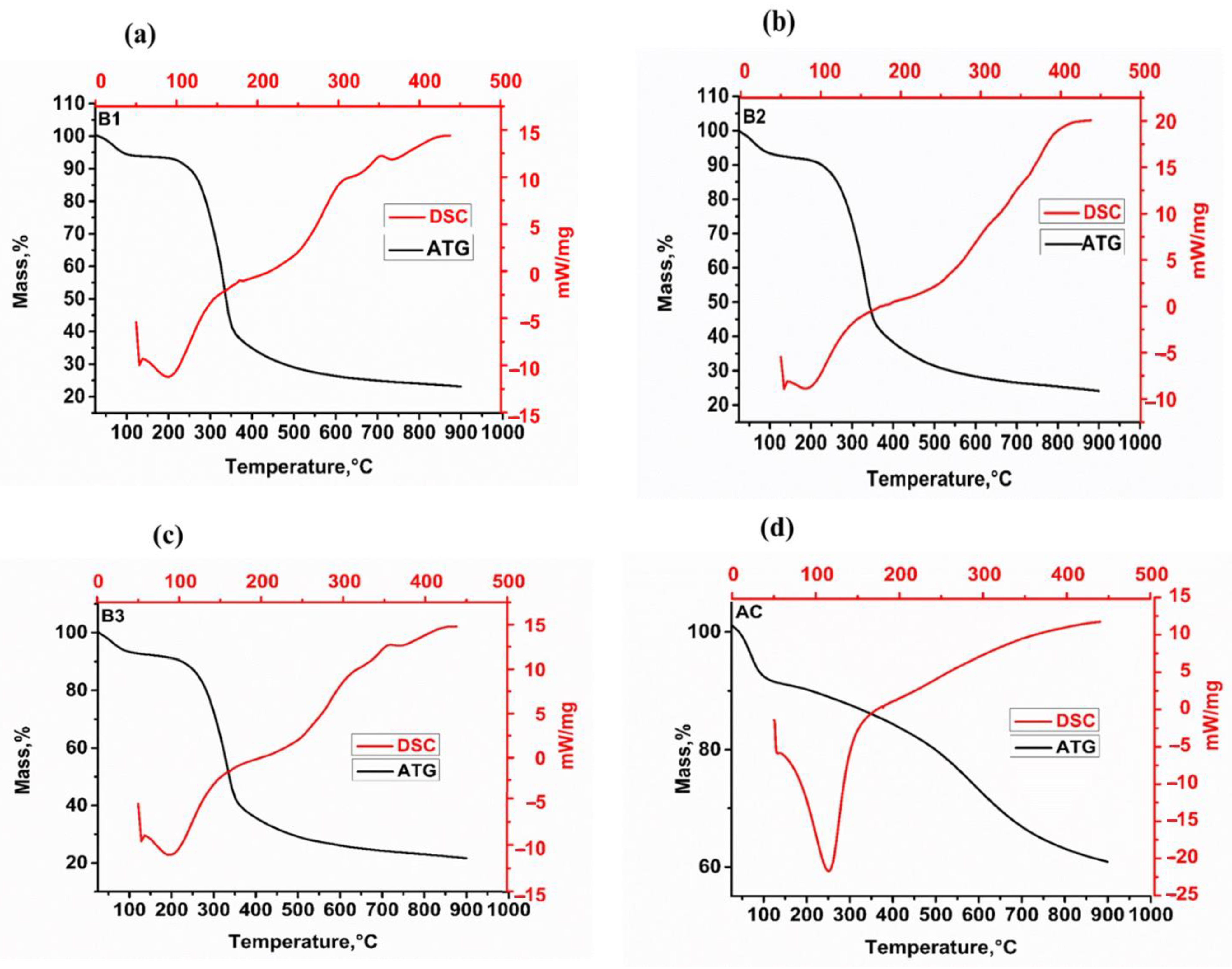
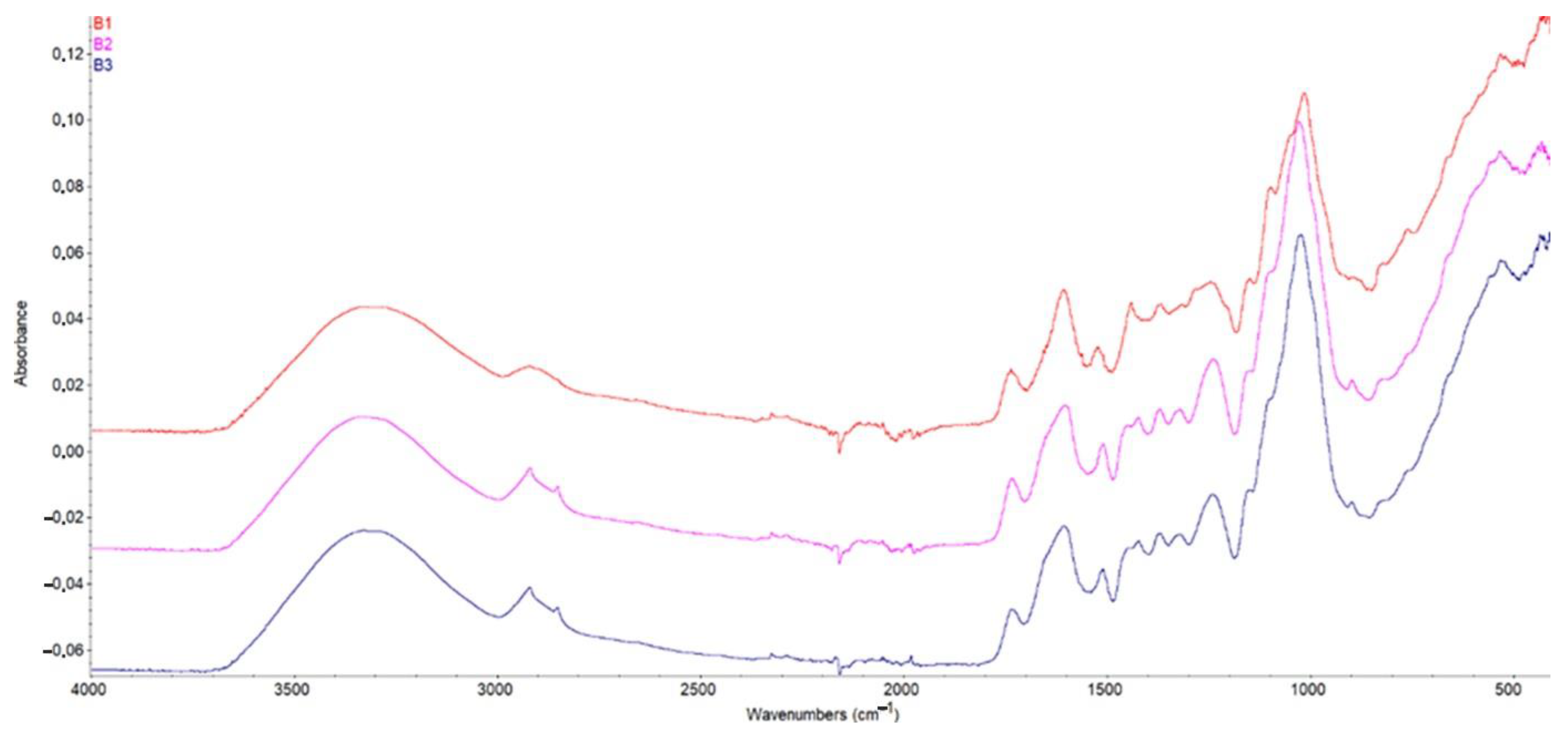
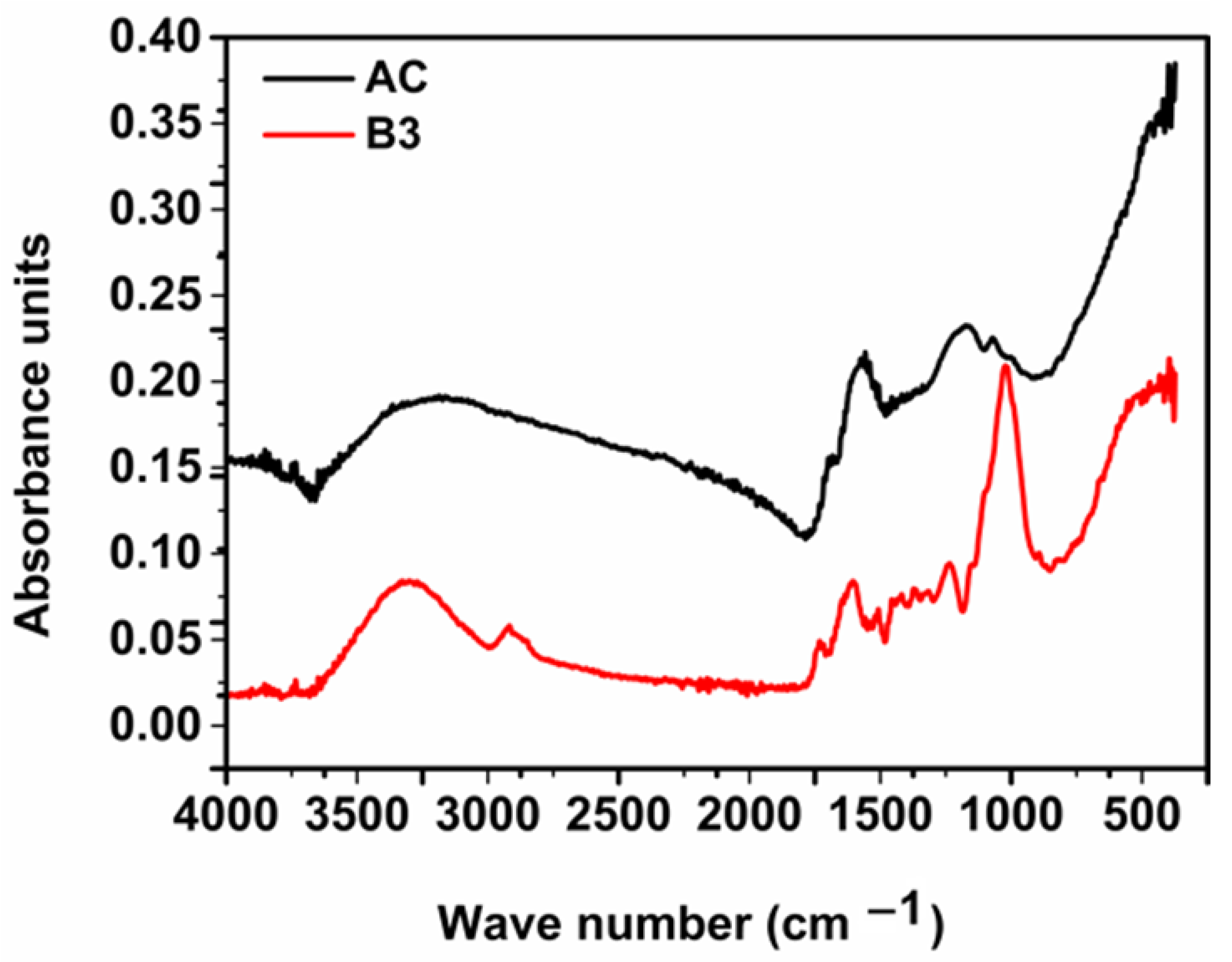
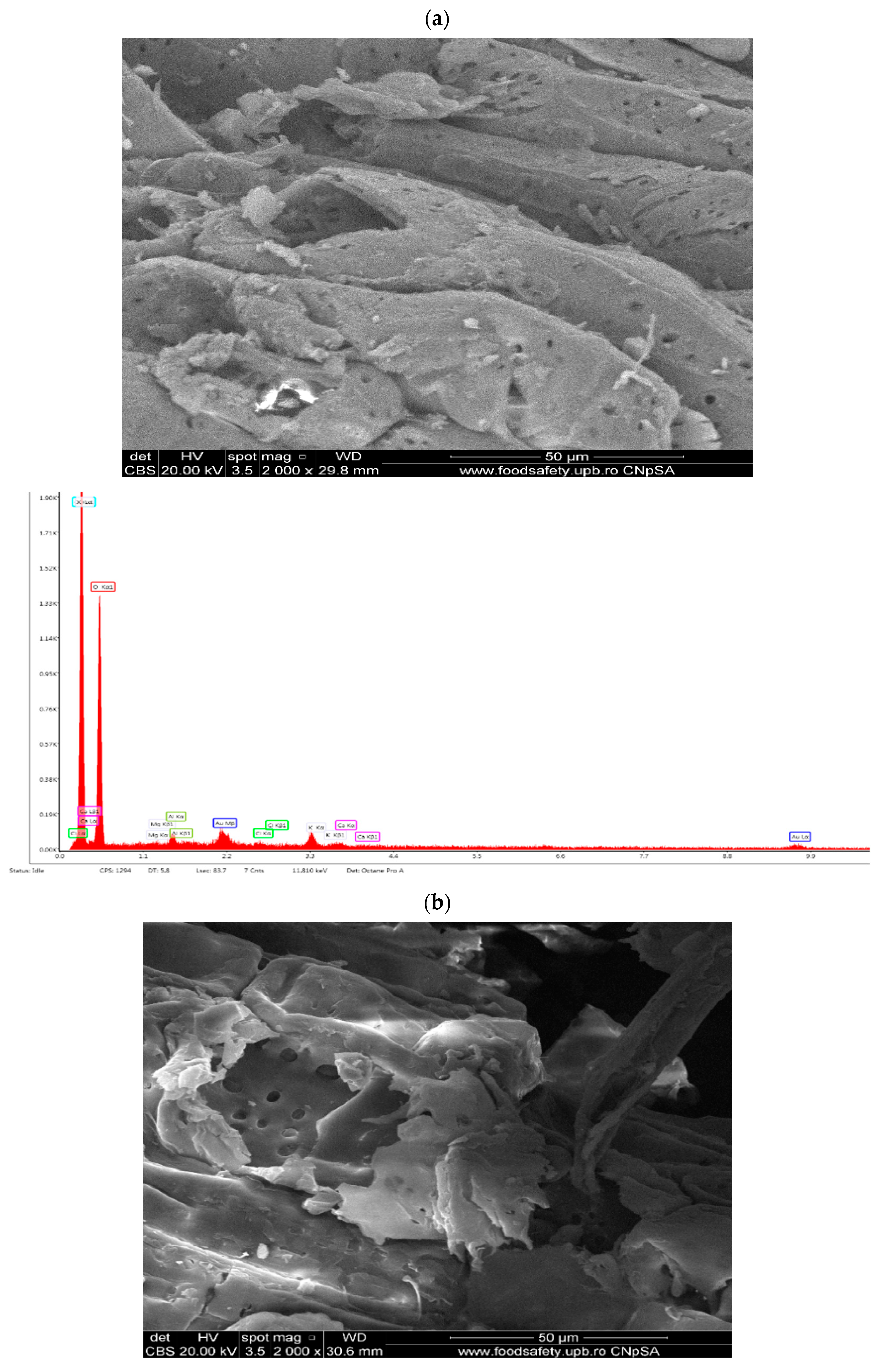

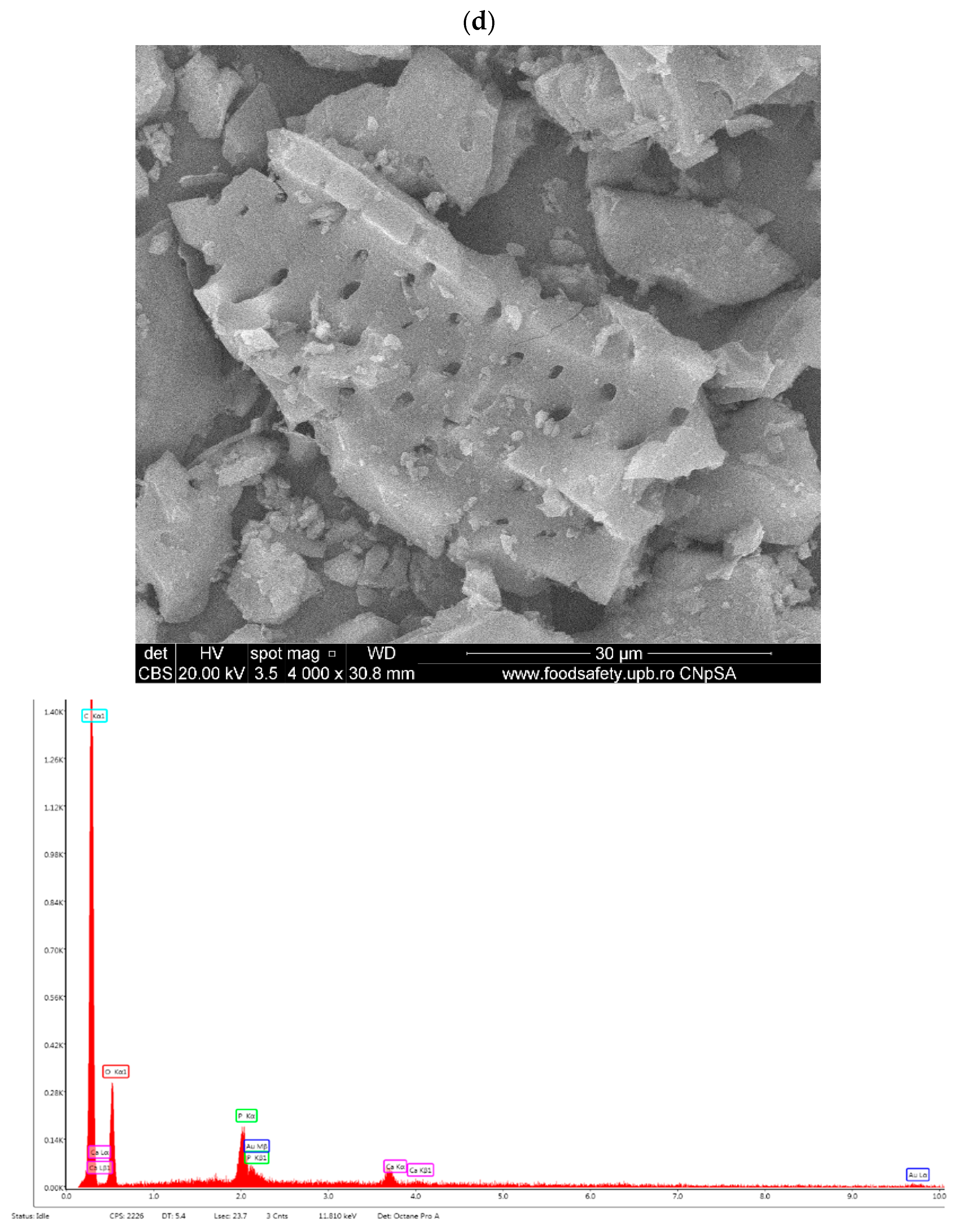
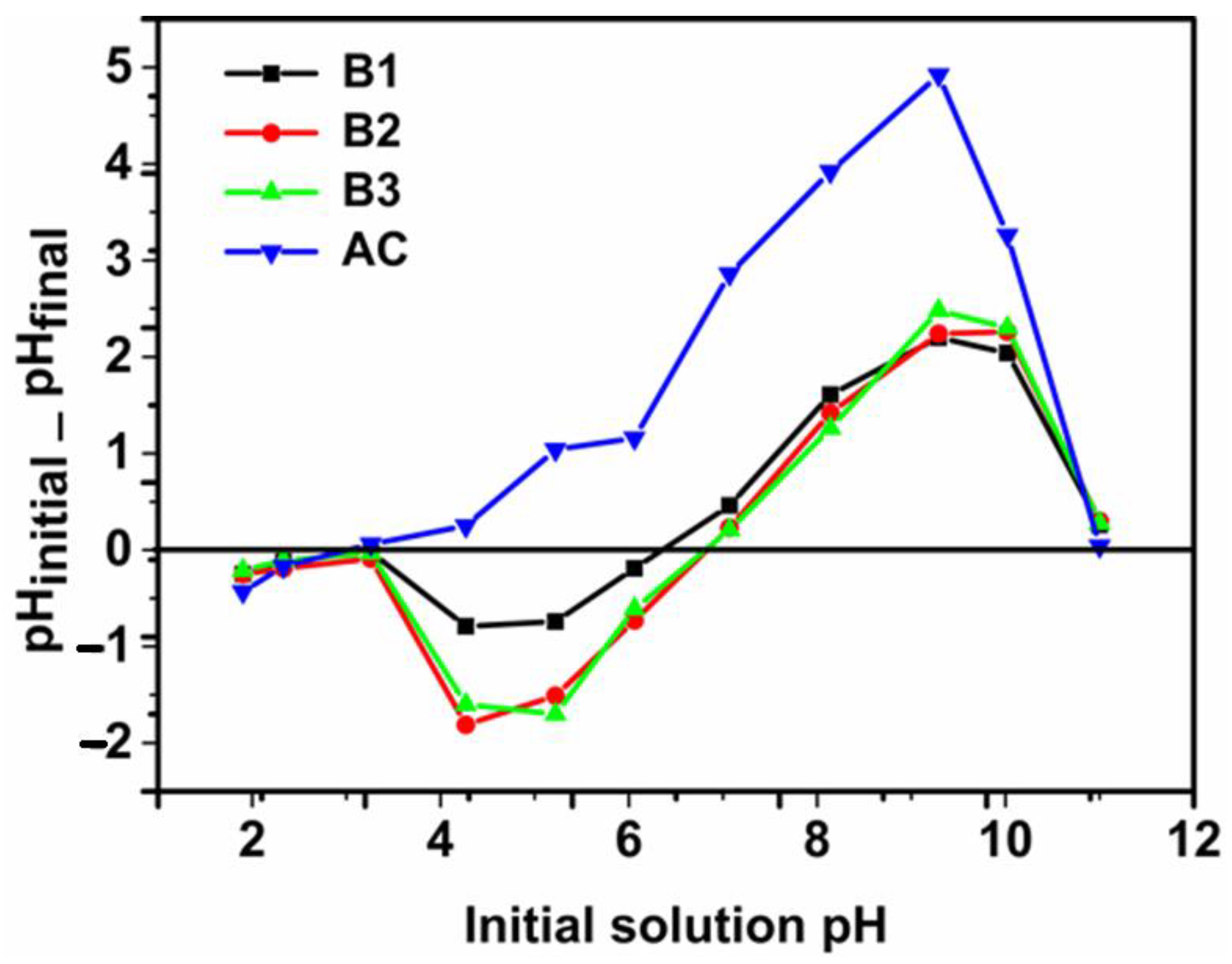


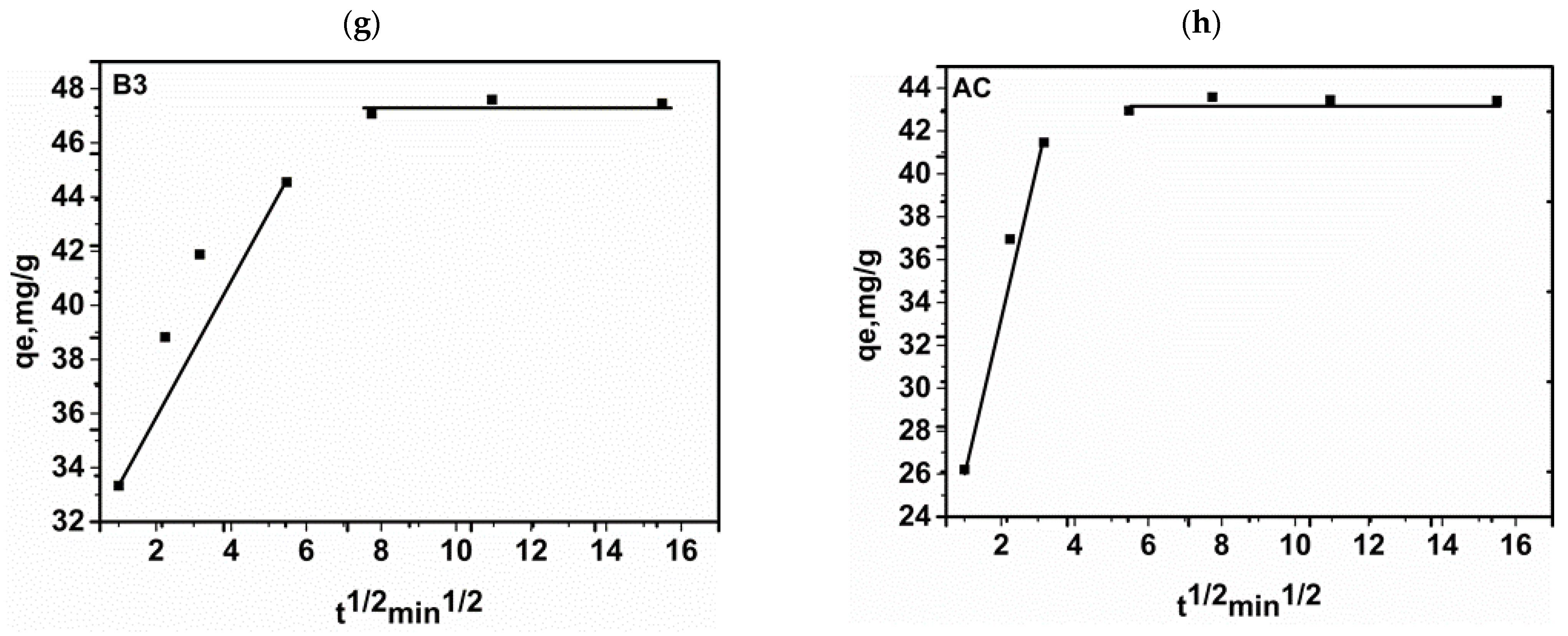
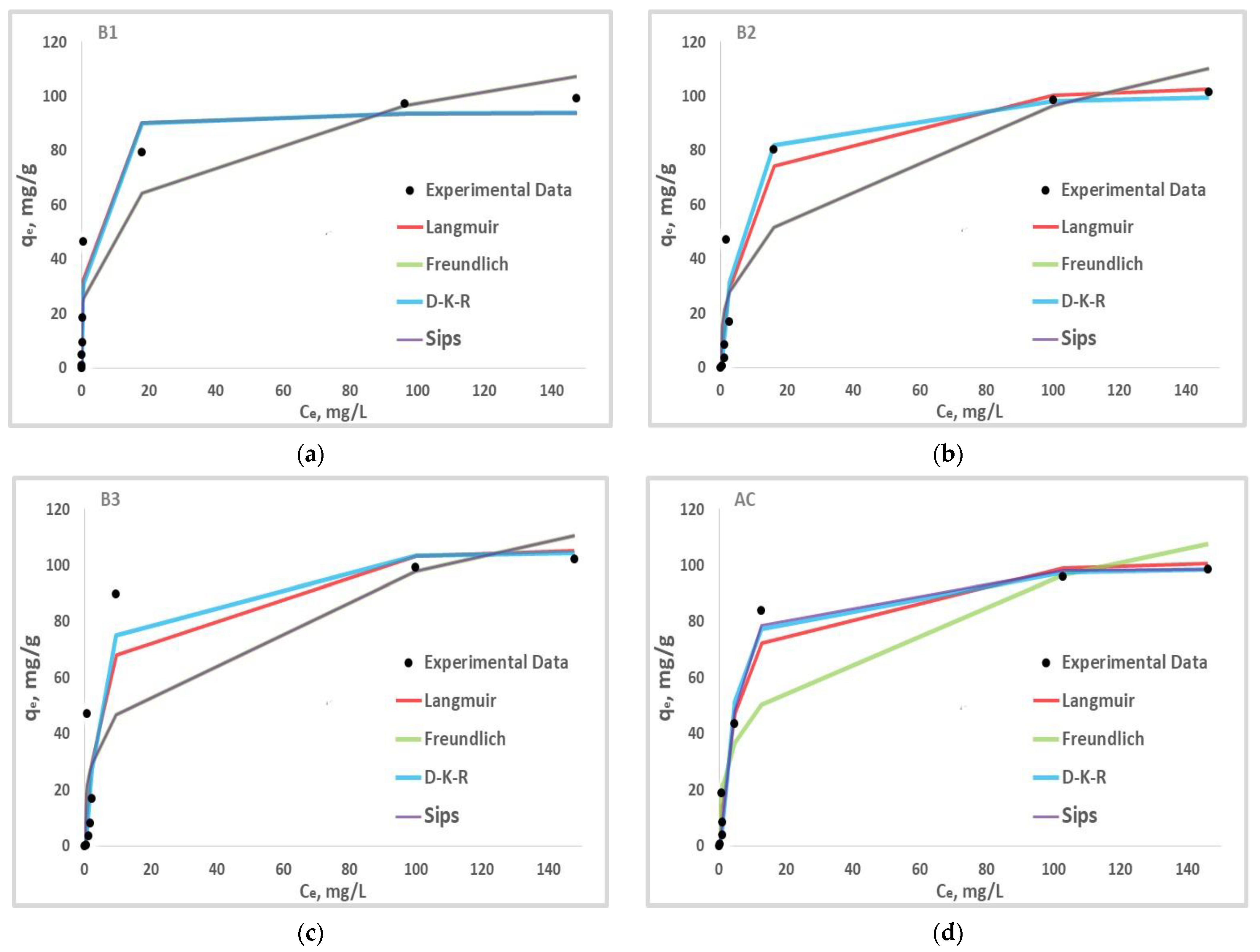

| Molecular structure |  |
| Molecular formula | C12H12N2O3 (5-ethyl-5-phenylbarbituric acid) |
| Molecular weight (g/mol) | 232.2 g/mol |
| pKa | 7.4 |
| Appearance | white powder |
| Melting temperature | 140 °C |
| solubility | Insoluble in water at 23 °C |
| Sample | qe mg·g−1 | Reference |
|---|---|---|
| B1 | 46.8 | This work |
| B2 | 47.0 | This work |
| B3 | 47.1 | This work |
| AC | 43.6 | This work |
| Powered AC | 0.41 | [36] |
| Granular AC | 0.29 | [36] |
| PES (polyethersulfone)—AC | 0.31 | [36] |
| Garcinia kola powdered seeds | 30.3 | [37] |
| Polymeric adsorbent | 2.485 | [38] |
| Unit | B1 | B2 | B3 | AC | |
|---|---|---|---|---|---|
| qe(exp) | (mg∙g−1) | 46.82 | 47.05 | 47.08 | 43.58 |
| Pseudo-first order model | |||||
| qe(cal) | (mg∙g−1) | 46.225 | 46.114 | 44.589 | 42.094 |
| k1 | (min−1) | 0.452 | 0.086 | 1.366 | 0.939 |
| R2 | / | 0.992 | 0.957 | 0.963 | 0.981 |
| RMSE | / | 1.649 | 4.410 | 3.252 | 2.230 |
| χ2 | / | 0.610 | 16.643 | 1.424 | 0.719 |
| Pseudo-second order model | |||||
| qe(cal) | (mg∙g−1) | 48.254 | 50.099 | 45.971 | 43.706 |
| K2 | (mg∙g−1∙min−1) | 0.016 | 0.002 | 0.049 | 0.033 |
| R2 | / | 0.994 | 0.977 | 0.985 | 0.998 |
| RMSE | / | 1.484 | 3.102 | 2.109 | 0.679 |
| χ2 | / | 0.352 | 6.735 | 0.631 | 0.073 |
| Elovich model | |||||
| A | (mg∙g−1∙min−1) | 2.22 × 103 | 22.915 | 893,573.914 | 104,317.757 |
| Β | (g∙min−1) | 0.225 | 0.125 | 0.367 | 0.342 |
| R2 | / | 0.903 | 0.973 | 0.995 | 0.963 |
| RMSE | / | 5.606 | 3.223 | 1.234 | 3.094 |
| χ2 | / | 5.403 | 1.550 | 0.207 | 1.579 |
| Intra-particle diffusion model | |||||
| Stage 1 | |||||
| Kid1 | (mg∙g−1∙min−1/2) | 12.28 | 5.54 | 2.39 | 7.14 |
| C1 | (mg∙g−1) | 8.19 | 6.78 | 32.52 | 19.63 |
| R2 | / | 0.96 | 0.99 | 0.88 | 0.97 |
| Stage 2 | |||||
| Kid2 | (mg∙g−1∙min−1/2) | 0.05 | 0.09 | 0.04 | 0.03 |
| C2 | (mg∙g−1) | 46.33 | 46.88 | 43.03 | |
| R2 | / | 0.75 | 0.73 | 0.39 | 0.24 |
| Kinetic Model | Mathematical Expression |
|---|---|
| Pseudo-first order | qt = q1 (1 − e−k1∙t) q1: is the maximum amount of solute adsorbed on the solid surface by mass of adsorbent at equilibrium (mg g−1) qt: is the amount of solute adsorbed on the solid surface at time t (mg g−1) k1: is pseudo-first-order kinetic constant (min−1) |
| Pseudo-second order | qt = qe: the maximum amount of solute adsorbed on the solid surface by mass of adsorbent at equilibrium (mg g−1) qt: is the amount of solute adsorbed on the solid surface at time t (mg g−1) k2: is pseudo-second order kinetic constant (mg g−1 min−1) t: contact time (min−1) |
| Intra-particle diffusion model | qt = t1/2 + C qt: absorbed mg g−1 at the t and equilibrium times Kid: (mg g−1 min−1) is constant intraparticle difusion C: is the intercept of the plot |
| Elovich | qt = ln (1 + αβt) α: initial rate constant β: desorption rate constant t: contact time (min−1) |
| Unit | B1 | B2 | B3 | AC | |
|---|---|---|---|---|---|
| Langmuir model | |||||
| qm | (mg∙g−1) | 94.295 | 107.553 | 109.296 | 104.575 |
| KL | (L∙mg−1) | 1.297 | 0.140 | 0.176 | 0.177 |
| RL | / | 0.025 | 0.192 | 0.159 | 0.159 |
| R2 | / | 0.964 | 0.922 | 0.851 | 0.973 |
| RMSE | / | 8.529 | 12.895 | 18.420 | 7.412 |
| χ2 | / | 17.826 | 60.812 | 128.493 | 21.342 |
| Freundlich model | |||||
| KF | (L∙g−1) | 32.131 | 20.134 | 23.354 | 22.818 |
| 1/n | / | 0.241 | 0.341 | 0.311 | 0.311 |
| R2 | / | 0.918 | 0.846 | 0.758 | 0.864 |
| RMSE | / | 12.899 | 18.109 | 23.497 | 16.753 |
| χ2 | / | 47.589 | 81.417 | 124.158 | 60.902 |
| D-K-R | |||||
| qS | (mg∙g−1) | 94.783 | 101.965 | 107.069 | 100.987 |
| Kad | (mol2∙J−2) | 0.0003 | 0.001 | 0.001 | 0.001 |
| E | (KJ∙mol−1) | 36.863 | 18.393 | 18.637 | 18.686 |
| R2 | / | 0.958 | 0.912 | 0.839 | 0.973 |
| RMSE | / | 9.372 | 13.828 | 19.420 | 7.568 |
| χ2 | / | 18.860 | 60.623 | 292.607 | 62.350 |
| Sips model | |||||
| qMs | (mg∙g−1) | 309,067.602 | 238,102.362 | 248,308.508 | 99.589 |
| KS | (L∙g−1) | 0.0001 | 8.453 × 10−5 | 9.40 × 10−5 | 0.109 |
| nS | / | 0.242 | 0.341 | 0.311 | 1.394 |
| R2 | 0.959 | 0.920 | 0.874 | 0.991 | |
| RMSE | 13.932 | 19.559 | 25.379 | 6.482 | |
| χ2 | 47.586 | 81.425 | 124.191 | 35.321 |
| Isotherms Models | Mathematical Expression |
|---|---|
| Langmuir | qe = qe: the amount of absorbate (mg g−1) Ce: absorbate equilibrium concentration (mg L−1) qm: Langmuir constant related to adsorption capacity KL: Langmuir constant related to energy of adsorption |
| Freundlich | qe = KFCe1∕n qe: the amount of absorbate (mg g−1) Ce: absorbate equilibrium concentration (mg L−1) KF: Freundlich constant related to adsorption capacity n: Freundlich constant related to adsorption intensit |
| D-K-R | qe = qm qe: the amount of absorbate (mg g−1) ε: polanyi potential KD: free energy |
| Sips | qe = qs: is the monolayer adsorption capacity (mg g−1) ns: describes the adsorbent surface heterogeneity Ks: Sips isotherm constant related to energy of adsorption (L mg−1) |
| Step | Sub-Sections | Cost Break-Up | Total Cost (USD/kg of Material) |
|---|---|---|---|
| Raw material processing | Collection of raw materials | Cost of raw material | 0.0 |
| Transportation cost | 0.48 | ||
| Preparation of biosorbent | Washing process | Washing cost 1 L of demineralized water corresponds to 0.16 USD, for this step we used 10 L of demineralized water. 5 × 0.16 = 0.8 | 0.8 |
| Preparation of biosorbent | Drying process | Drying cost Hours × power × unit cost = 24 × 0.75 × 0.16 | 2.88 |
| Preparation of biosorbent | Crushing process | Crushing cost 1 kg crushed in the machine corresponds to 1.66 USD | 1.66 |
| TOTAL | 5.82 | ||
| Preparation of AC | Impregnation with H3PO4 | Impregnation with H3PO4 cost Hours × power × unit cost + amount of H3PO4 × unit cost = 2 × 0.75 × 1.6 + 6.3 mL × 176.26/2500 mL | 2.84 |
| Preparation of AC | Carbonization process (AC) | Carbonization cost Hours × power × unit cost = 1.37 × 1.8 × 0.16 | 0.39 |
| Preparation of AC | Drying process (AC) | Drying cost Hours × power × unit cost = 24 × 0.75 × 0.16 | 2.88 |
| Preparation of AC | Washing process (AC) | Washing cost 1 L of demineralized water corresponds to 0.16 USD, for this step we used 10 L of demineralized water. 10 × 0.16 = 1.6 | 1.6 |
| TOTAL | 8.19 |
Disclaimer/Publisher’s Note: The statements, opinions and data contained in all publications are solely those of the individual author(s) and contributor(s) and not of MDPI and/or the editor(s). MDPI and/or the editor(s) disclaim responsibility for any injury to people or property resulting from any ideas, methods, instructions or products referred to in the content. |
© 2024 by the authors. Licensee MDPI, Basel, Switzerland. This article is an open access article distributed under the terms and conditions of the Creative Commons Attribution (CC BY) license (https://creativecommons.org/licenses/by/4.0/).
Share and Cite
Ndankou, C.S.D.; Ștefan, D.S.; Nsami, N.J.; Daouda, K.; Bosomoiu, M. Evaluation of Phenobarbital Adsorption Efficiency on Biosorbents or Activated Carbon Obtained from Adansonia Digitata Shells. Materials 2024, 17, 1591. https://doi.org/10.3390/ma17071591
Ndankou CSD, Ștefan DS, Nsami NJ, Daouda K, Bosomoiu M. Evaluation of Phenobarbital Adsorption Efficiency on Biosorbents or Activated Carbon Obtained from Adansonia Digitata Shells. Materials. 2024; 17(7):1591. https://doi.org/10.3390/ma17071591
Chicago/Turabian StyleNdankou, Charnella Stevine Dibandjo, Daniela Simina Ștefan, Ndi Julius Nsami, Kouotou Daouda, and Magdalena Bosomoiu. 2024. "Evaluation of Phenobarbital Adsorption Efficiency on Biosorbents or Activated Carbon Obtained from Adansonia Digitata Shells" Materials 17, no. 7: 1591. https://doi.org/10.3390/ma17071591







